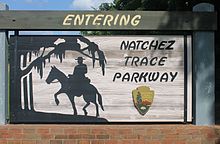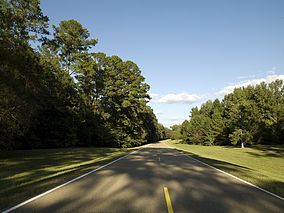|
Natchez Trace Parkway
The Natchez Trace Parkway is a limited-access national parkway in the Southeastern United States that commemorates the historic Natchez Trace and preserves sections of that original trail. Its central feature is a two-lane road that extends 444 miles (715 km) from Natchez, Mississippi, to Nashville, Tennessee. Access to the parkway is limited, with more than 50 access points in Mississippi, Alabama, and Tennessee. The southern end of the route is in Natchez at its intersection with Liberty Road, and the northern end is northeast of Fairview, Tennessee, in the suburban community of Pasquo, at an intersection with Tennessee State Route 100. In addition to Natchez and Nashville, larger cities along the route include Jackson and Tupelo, Mississippi, and Florence, Alabama.[5][6] MaintenanceThe road is maintained by the National Park Service and has been designated an All-American Road. Commercial traffic is prohibited along the entire route, and the speed limit is 50 miles per hour (80 km/h), except north of Leiper's Fork, Tennessee, and Ridgeland, Mississippi, where the speed limit is reduced to 40 miles per hour (64 km/h). The total area of the parkway is 51,746.50 acres (209.4 km2), of which 51,680.64 acres (209.1 km2) are federal and 65.86 acres (0.3 km2) are not. Unlike the older Blue Ridge Parkway in Virginia and North Carolina, the Natchez Trace Parkway does feature direct interchanges with Interstate Highways. The parkway is headquartered in Tupelo and has nine district offices: Leipers Fork, Meriwether Lewis, Cherokee, Tupelo, Dancy, Kosciusko, Ridgeland, Port Gibson, and Natchez. The parkway also manages two battlefields: Brices Cross Roads National Battlefield Site and Tupelo National Battlefield.[7] HistoryFootpathThe gentle sloping and curving alignment of the current route closely follows the original foot passage. Its design harkens back to the way the original interweaving trails aligned as an ancient salt lick-to-grazing pasture migratory route of the American bison and other game that moved between grazing the pastures of central and western Mississippi and the salt and other mineral surface deposits of the Cumberland Plateau. The route generally traverses the tops of the low hills and ridges of the watershed divides from northeast to southwest. Native Americans, following the "traces" of bison and other game, further improved this walking trail for foot-borne commerce between major villages located in central Mississippi and middle Tennessee. The route is locally circuitous, but by traversing this route, the bison, and later humans, avoided the endless, energy-taxing climbing and descending of the many hills along the way. Also avoided was the danger to a herd (or groups of human travelers) of being caught en masse at the bottom of a hollow or valley if attacked by predators. The nature of the route, to this day, affords good all-around visibility for those who travel it. At all times, the road is on the high ground of the ridge dividing the watersheds and provides a view to either see or catch the scent of danger, from a distance great enough to afford the time to flee to safety, if necessary.  By the time of European exploration and settlement, the route had become well known and established as the fastest means of communication between the Cumberland Plateau, the Mississippi River, and the Gulf of Mexico settlements of Pensacola, Mobile, and New Orleans. In the early post-American Revolutionary War period of America's (south) westward expansion, the trace was the return route for American flat-boat commerce between the territories of the upper and lower Ohio, Tennessee, and Cumberland River valleys. The Americans constructed flat boats, loaded their commerce therein, and drifted upon those rivers, one-way south-southwestward to New Orleans, Louisiana. They would then sell their goods (including the salvageable logs of the flat boats and including enslaved people), and return home via the trace (for the middle section of their return trip), to as far away as Pittsburgh, Pennsylvania. Improved communications (steam boats, stagecoach lines, and railroads) and the development of ports along the rivers named above (e.g., Natchez; Memphis, Tennessee; Paducah, Kentucky; Nashville, Tennessee; and Louisville, Kentucky) made the route obsolete as a means of passenger and freight commerce. As a result, no major population centers developed along the trace, because of its alignment, between its termini in Nashville and Natchez. The two cities of note, near or on the trace's alignment (Jackson and Tupelo, Mississippi), developed only as a result of their alignment along axes of communication different from the trace. Thus, the trace and its alignment are today almost entirely undeveloped and unspoiled along its whole route. Many sections of the original footpath are visible today for observing and hiking the parkway's right-of-way. The Natchez Trace National Scenic Trail includes five sections of hiking and horse-riding trails. Civilian Conservation Corps Construction of the parkway was begun by the federal government in the 1930s, one of the many projects of the Civilian Conservation Corps during the Great Depression. The road was the proposal of U.S. Congressman T. Jeff Busby of Mississippi, who proposed it as a way to give tribute to the original Natchez Trace. Inspired by the proposal, the Daughters of the American Revolution began planting markers and monuments along the trace. In 1934, the Franklin Delano Roosevelt administration ordered a survey. President Roosevelt signed the legislation to create the parkway on May 18, 1938.[7] Construction on the Parkway began in 1939, and the route was to be overseen by the National Park Service. Its length includes more than 45,000 acres (182 km2) and the towering Natchez Trace Parkway Bridge in Williamson County, Tennessee, completed in 1994 and one of only two post-tensioned, segmental concrete-arch bridges in the world. The Emergency Appropriations Act of June 19, 1934, allocated initial construction funds and established it as a parkway under National Park Service by the act of May 18, 1938. Gaps and completion For many years in the later 20th century, most of the trace had been complete, but owing to a lack of funds, two gaps remained, both in Mississippi. One was a several-mile-long bypass of Jackson, between Interstate 55 at Ridgeland and Interstate 20 at Clinton. The other was between Liberty Road in the city of Natchez and U.S. Highway 61 near Washington. These final two segments were finally completed and opened on May 21, 2005. In 2013, a new law required the National Park Service (NPS) to convey about 67 acres of property in the Natchez Trace Parkway to the State of Mississippi. It also adjusted the boundaries of the parkway to include 10 additional acres. The two pieces of land in question originally belonged to Mississippi and were donated to the NPS when it was trying to determine where to end the Natchez Trace Parkway.[8][9][10] Historical sites Numerous historical sites on the Parkway include the Meriwether Lewis Museum, the refurbished Mount Locust stand, Historic French Camp, MS, and the Mississippi Craft Center in Ridgeland, Mississippi, which focuses on promoting Mississippi's native art. Between the Parkway and Old Port Gibson Road is the ghost town of Rocky Springs that thrived in the late 19th century. The old Rocky Springs Methodist Church, the cemetery, and several building sites still exist and are accessible from the parkway. Cypress Swamp is located at mile post 122. Also, several cascading waterfalls can be viewed; for access, some require a bit of hiking from the parkway. Besides, parts of the original trail are still accessible. The history of the Natchez Trace, including the parkway, is summarized at the Natchez Trace Visitor Center in Tupelo.[11] Emerald Mound, the second-largest Native American ceremonial mound in the United States, is located just west of the trace and north of Highway 61 near Natchez. It offers a unique look at the ingenuity and industry of native culture. Two smaller mounds rise from the top of the main mound and rise above treetops, offering a wide view. Travelers can reach Emerald Mound with a five-minute detour from the main trace highway. Emerald Mound measures 770 feet (230 m) by 435 feet (133 m) at the base and is 35 feet (11 m) in height. The mound was built by depositing earth along the sides of a natural hill, thus reshaping it and creating an enormous artificial plateau. The Ackia Battleground National Monument (established August 27, 1935, and now called Chickasaw Village) and Meriwether Lewis Park (proclaimed as Meriwether Lewis National Monument February 6, 1925, and transferred from the War Department August 10, 1933) were added to the parkway by the act of August 10, 1961. Parkway highlightsHighlights include: Natchez to Jackson
Jackson to Tupelo
Tupelo to Tennessee state line
Tennessee
Exit listMileage based on physical mileposts along the parkway. All exits are unnumbered.
Gallery
See alsoReferences
External linksWikimedia Commons has media related to Natchez Trace Parkway. Wikivoyage has a travel guide for Natchez Trace Parkway. KML is from Wikidata
|
||||||||||||||||||||||||||||||||||||||||||||||||||||||||||||||||||||||||||||||||||||||||||||||||||||||||||||||||||||||||||||||||||||||||||||||||||||||||||||||||||||||||||||||||||||||||||||||||||||||||||||||||||||||||||||||||||||||||||||||||||||||||||||||||||||||||||||||||||||||||||||||||||||||||||||||||||||||||||||||||||||||||||||||||||||||||||||||||||||||||||||||||||||||||||||||||||||||||||||||||||||||||||||||||||||||||||||||||||||||||||||||||||||||||||||||||||||||||||||||||||||||||||||||||||||||||||||||||||||||||||||||||||||||||||||||||||||||||||||||||||||||||||||||||||||||||||||||||||||||||||||||||||||||||||||||||||||||||||||||||||||||||||||||||||||||||||||||||||||||||||||||||||||||||||||||||||||||||||||||||||||||||||||||||||||||||||||||||||||||||||||||||||||||||||||||||||||||||||||||||||||||||||||||||||||||||||||||||||||||||||||||||||||||||||||||||||||||||||||||||||||||||||||||||||||||||||||||||||||||||||||||||||||||||||||||||||||||||||||||||||||||||||||||||||||||||||||||||||









